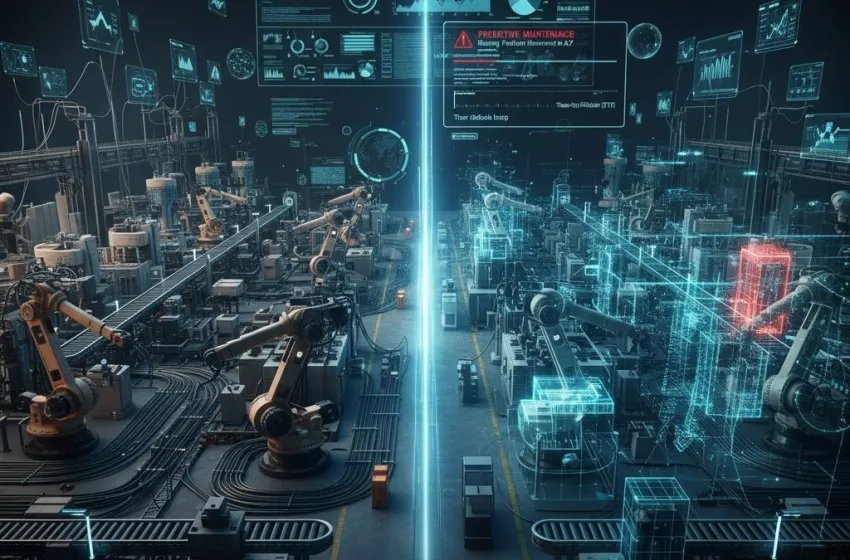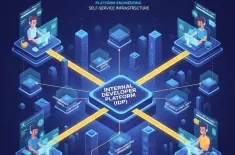Unlock the power of Digital Twins for complex industrial systems.
The industrial landscape is undergoing a profound transformation, driven by the convergence of physical assets and digital intelligence. At the heart of this revolution is the Digital Twin, a sophisticated, dynamic virtual replica of a physical asset, process, or system to model its behavior, test changes, and predict failures in real-time. For complex systems—such as smart factories, city-wide infrastructure, aerospace engines, or massive oil and gas facilities—the Digital Twin is not merely a model; it is a live, breathing mirror world that enables unprecedented levels of optimization, efficiency, and reliability.
This technology moves far beyond traditional simulation. By continuously integrating real-time data from the physical world, the Digital Twin becomes a physical-virtual model that accurately reflects its counterpart’s current state, past performance, and potential future behavior. This capability is rapidly becoming indispensable for industries looking to navigate the intricacies of large-scale, interconnected operations.
The Core Architecture of the Digital Twin for Complex Systems
A successful Digital Twin implementation for a complex system is built upon three interconnected pillars: the physical asset, the virtual model, and the data connection layer.
The Physical Asset and Data Acquisition
The journey begins with the physical entity—a piece of machinery, a production line, or an entire smart city grid. To create a Digital Twin, this physical world must be instrumented with a vast network of sensors, meters, and monitoring devices. This is where the industrial IoT (IIoT) ecosystem plays a foundational role.
- IIoT Integration: IIoT devices collect a continuous stream of data on crucial parameters, including temperature, pressure, vibration, flow rates, energy consumption, and environmental factors. For complex systems, the sheer volume and velocity of this data are enormous, demanding robust edge computing and high-speed communication networks.
- Data Aggregation and Pre-processing: The raw data collected by IIoT sensors is aggregated, cleaned, and standardized. This process ensures the data used to feed the virtual model is accurate and reliable, which is critical for maintaining the fidelity of the physical-virtual model.
The Virtual Model (The Twin)
The virtual component is the true intellectual property of the Digital Twin. It is a highly detailed, multi-dimensional digital construct that encapsulates the physical system's geometry, physics, behavior, and rules of operation.
- Multi-Fidelity Modeling: For complex systems, the virtual model often comprises multiple sub-models—a twin of an individual component, a twin of a process, and a twin of the entire system (a "system of systems" twin). These models use a combination of physics-based modeling (relying on the laws of mechanics, thermodynamics, and fluid dynamics) and data-driven modeling (leveraging machine learning and AI to learn the system's behavior from historical and real-time data).
- Real-Time Synchronization: Unlike a static simulation, the Digital Twin is alive. Its real-time simulation engine processes the incoming IIoT data to continuously update the virtual state. This constant synchronization ensures that the digital replica perfectly mirrors the current condition, performance, and environmental context of its physical counterpart.
Analytics and the Feedback Loop
The ultimate value of the Digital Twin is realized through the insights generated by its analytical layer, which completes the dynamic feedback loop.
- Advanced Analytics: The synchronized physical-virtual model is subjected to advanced algorithms, including machine learning, deep learning, and real-time simulation models. These tools analyze historical trends, detect anomalies, and process real-time data to forecast outcomes.
- Decision Support: The insights derived are then translated into actionable intelligence. This intelligence flows back to the operators and sometimes directly to the physical system via actuators, enabling autonomous or assisted decision-making. This constant loop is essential for achieving true optimization and control in complex systems.
Key Applications and the Power of Predictive Maintenance
The application of Digital Twins fundamentally shifts operational strategies from reactive to proactive, offering profound benefits across the entire lifecycle of a complex system.
Predictive Maintenance and Asset Lifecycle Management
One of the most immediate and valuable applications of the Digital Twin is in predictive maintenance. In complex industrial or infrastructural environments, unplanned downtime can cost millions per hour.
- Failure Prediction: By constantly comparing the real-time data from the physical asset against the virtual model's expected performance, the Digital Twin can detect subtle anomalies that signal impending failure—long before human operators or traditional monitoring systems would. For example, a twin of a gas turbine can correlate slight increases in vibration with specific historical wear patterns to forecast a component failure with high accuracy.
- Condition-Based Scheduling: Instead of relying on time-based or reactive maintenance, the Digital Twin enables condition-based maintenance. Maintenance is scheduled precisely when the model predicts the component will reach a critical state, minimizing unnecessary interventions, optimizing resource allocation, and extending the asset's lifespan. The result is a substantial reduction in both maintenance costs and unplanned downtime.
Operational Intelligence and Process Optimization
Digital Twins are crucial for optimizing processes and achieving higher throughput and efficiency across sprawling, interconnected operations. This is often referred to as delivering operational intelligence.
- Scenario Testing and 'What-If' Analysis: A key advantage of the physical-virtual model is the ability to run simulations without risking the real-world asset. Engineers can test new operational parameters, firmware updates, or process changes in the Digital Twin environment. If an aerospace manufacturer wants to optimize the fuel consumption of an engine, they can virtually run millions of flight hours in the twin, identifying the optimal control settings before deploying them to the actual aircraft.
- Root Cause Analysis: When an event or failure does occur in the physical world, the Digital Twin can be used for rapid root cause analysis. By playing back the logged real-time data and simulating the chain of events within the virtual environment, engineers can quickly pinpoint the exact source of the issue, drastically reducing troubleshooting time.
- Energy and Resource Management: By simulating material flow, energy usage, and thermal dynamics across an entire factory or building, the Digital Twin provides operational intelligence that allows operators to fine-tune systems for peak energy efficiency and minimized waste.
Design, Prototyping, and Commissioning
The use of Digital Twins begins long before the physical asset is built. By creating a virtual replica in the design phase, manufacturers can:
- Accelerate Product Development: Designers can iterate on components and test system performance against design specifications using the physical-virtual model. This reduces the need for costly and time-consuming physical prototypes.
- Virtual Commissioning: For complex systems like large automated warehouses or production lines, the control software can be tested against the Digital Twin before it's deployed to the actual machinery. This ensures that when the physical system is built, the commissioning process is dramatically faster and safer.
The Synergy with Industrial IoT (IIoT)
The relationship between the Digital Twin and the industrial IoT (IIoT) is symbiotic. IIoT provides the eyes, ears, and nerves of the system, gathering the raw, granular real-time data necessary to keep the twin synchronized.
- Data Volume and Velocity: Complex systems generate petabytes of data from thousands of endpoints. The IIoT infrastructure, including edge computing devices, ensures that only relevant, high-quality data is transmitted to the cloud or enterprise servers for analysis and real-time simulation.
- Contextual Awareness: The fusion of data in the physical-virtual model gives the raw IIoT data context. A sensor reading of 180°C on a bearing means little on its own. Within the Digital Twin, that reading is immediately contextualized against the component's load, speed, historical temperature trends, and maintenance history, triggering a predictive maintenance alert with an estimated Time-to-Failure (TTF). This transformation of data into operational intelligence is the fundamental value proposition.
Challenges in Implementing Digital Twins for Complex Systems
While the benefits are clear, deploying a Digital Twin for complex systems presents significant challenges that must be addressed:
- Data Quality and Integration: The Digital Twin is only as good as the data feeding it. Ensuring high-fidelity, standardized, and secure data flow from disparate IIoT sources is a major technical hurdle.
- Model Complexity and Computational Demand: Creating a virtual replica of a system-of-systems, such as a national power grid or a major port, requires sophisticated, multi-domain models and immense computational resources to run real-time simulation and advanced AI analytics.
- Interoperability and Standardization: Complex industrial environments often involve equipment from multiple vendors with proprietary data formats. Lack of common standards for Digital Twin representation (sometimes referred to as the "Digital Twin Definition Language") hampers seamless integration and scalability.
- Security: Given that the Digital Twin connects the virtual world with critical physical-virtual model control, securing the IIoT network, the data streams, and the twin itself from cyber-attacks is paramount.
The Future Trajectory: Autonomous Operations
The ultimate goal of the Digital Twin for complex systems is to enable autonomous, self-optimizing operations. As the real-time simulation and operational intelligence layers become more sophisticated through the use of advanced AI and Machine Learning, the twin can begin to execute corrective actions on its own, based on its predictive maintenance forecasts and optimization models.
Imagine an entire supply chain that uses interconnected Digital Twins of its factories, logistics networks, and vehicles. If a disruption occurs at a node, the collective system twins creating a virtual replica of the entire chain, can instantly run simulations to reroute production, update delivery schedules, and notify stakeholders—all without human intervention. This vision of a self-healing, self-optimizing enterprise, driven by the dynamic physical-virtual model of the Digital Twin, represents the pinnacle of Industry 4.0 and the future of managing the world's most intricate and critical systems.



























